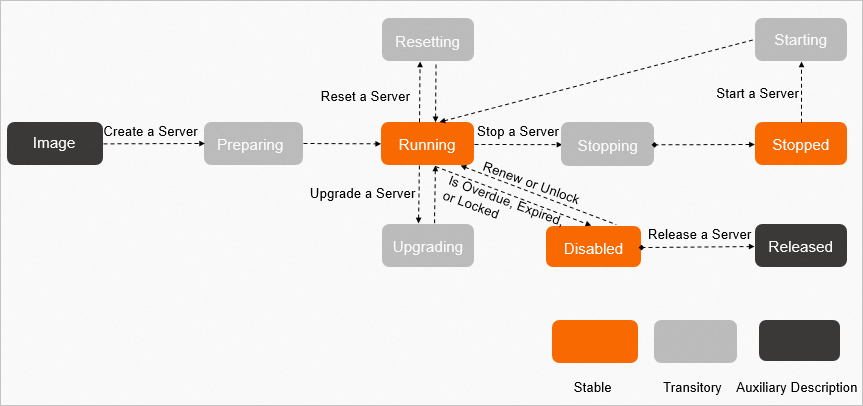The lifecycle of a simple application server spans the entire process from creation to release of the server. During the process, the simple application server transits between different status. This topic describes the status of a simple application server throughout its lifecycle.
Status of simple application servers
The following table describes the status that a simple application server may enter during its lifecycle.
State in the console | State in an API call response | State type | Description |
Preparing | Pending | Transitory | During the creation of a simple application server, the server enters this state and then the Starting state. |
Starting | Starting | Transitory | After a simple application server is created, started, or restarted, the server enters this state and then the Running state. |
Running | Running | Stable | A simple application server is running as expected and can be accessed only when it is in this state. Important Simple application servers that are about to expire are also in this state. We recommend that you take note of the remaining service lifetime of a simple application server after the server enters this state. |
Stopping | Stopping | Transitory | After you stop or restart a simple application server, the server enters this state and then the Stopped state. |
Stopped | Stopped | Stable | After you stop a simple application server, it enters the Stopping state and then this state. |
Resetting | Resetting | Transitory | After you reset a simple application server, the server enters this state and then the Running state. |
Upgrading | Upgrading | Transitory | After you upgrade the resource plan of a simple application server, the server enters this state and then the Running state. |
Disabled | Disabled | Stable | If a simple application server expires, is stopped due to overdue payments, or is locked due to security risks, the server enters this state. Warning
|
Manage status of simple application servers
The following figure shows the transitions between status of a simple application server.
If you stop, restart, upgrade, or reset a simple application server, the status of the server is affected. The following list describes the common operations for managing status of simple application servers:
Create a simple application server
The server enters the Preparing (Pending) state and then the Running state. When the server is in the Running state, you can access the server. For example, you can connect to the server to manage its operating system configurations, or build websites on the server and then access the websites by using a browser. For more information, see Create a server.
Stop a simple application server
The server enters the Stopping state and then the Stopped state. If you do not need a server for the moment, you can temporarily stop the server on the server card. For more information, see View the card of a server on the Servers page.
ImportantYou can stop simple application servers only when they are in the Running state.
Start a simple application server
The server enters the Starting state and then the Running state. If a simple application server is in the Stopped state, you can start the server on the server card. For more information, see View the card of a server on the Servers page.
ImportantYou can start simple application servers only when they are in the Stopped state.
Restart a simple application server
The server enters the Stopping state, the Starting state, and then the Running state. After you perform specific operations, you must restart the server to allow the operations to take effect. For example, after you set a password for a simple application server, you must restart the server to allow the password to take effect. For more information, see Set or reset the password of a server.
ImportantYou can restart simple application servers only when they are in the Running state.
Reset a simple application server
The server enters the Resetting state and then the Running state. For more information, see Reset a simple application server.
Upgrade a simple application server
The server enters the Upgrading state and then the Running state. If the current server specification does not meet your business requirements, you can upgrade the resource plan of the server. For more information, see Upgrade a simple application server.
Release a simple application server
You can release simple application servers only when they expire and are in the Disabled state. If a simple application server expires and is no longer needed, you can manually release the server or wait for the system to automatically release the server. For more information, see Release a simple application server.